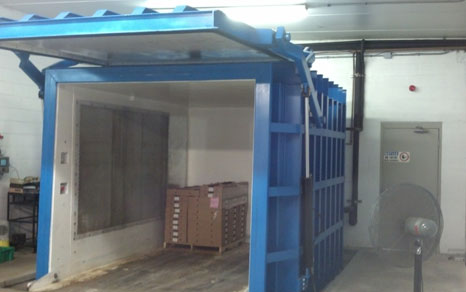
In order to perform efficient vacuum cooling there are several considerations to be followed. While the basic concepts or methods applied when vacuum cooling are easy to understand, great care must be taken when integrating all of the “separate” systems and their components together. This will ensure that the vacuum cooler chamber, vacuum pump system, and refrigeration system work together to achieve optimum and efficient cooling results.
The basic functions that each of the “components” of the vacuum cooling system perform are as follows:

The vacuum chamber is used to hold the product desired to be cooled. The vacuum chamber is constructed in a way that reduces its overall interior volume. While the goal is to achieve as small a volume as possible, it stands that adequate “room” is required to easily load and unload the palletized product to be cooled.
The vacuum system evacuates the air contained in the entire vacuum chamber. This evacuation, causing the drop in pressure inside the chamber, is what provides the opportunity for the product inside the chamber to drop in temperature by means of “evaporative cooling”. “Evaporative cooling” is achieved as the moisture in the product “boils off” under the reduced pressure inside the vacuum chamber.
The air to be evacuated from the vacuum chamber not only includes the air surrounding the palletized product but also the air that is in empty spaces found inside the boxes or cartons of the product to be cooled. The vacuum system should be sized adequately to lower the atmospheric pressure in the vacuum cooler at an acceptable rate. A vacuum system that is oversized can add extra, unnecessary equipment and operational costs to your vacuum cooling system.
The refrigeration system for the vacuum cooler is used to re-condense the heat laden vapor that is “boiled off” from the product being cooled. This allows the vacuum system to continue lower the atmospheric pressure inside the chamber resulting in further cooling of the fresh product. The re-condensing of the vapor also prevents the moisture from getting into the vacuum pumps. Excess moisture in the vacuum pumps has the potential to re-condense in the lubricating oil in the pumps.
This will lead to reduced performance and speed when it comes to evacuating the chamber, and it will also shorten the operating life of the vacuum pumps. As can be seen from the explanation above, it is required that each of the functional components of a vacuum cooling system is engineered and sized appropriately to prevent them working against each other. Only when a balanced system is put together, will a vacuum cooler perform its job efficiently, with acceptable cycle times, and in a cost effective way.
Do you need an efficient vacuum cooling solution for your fresh produce or fresh food products?
Contact Agrimaint Today!